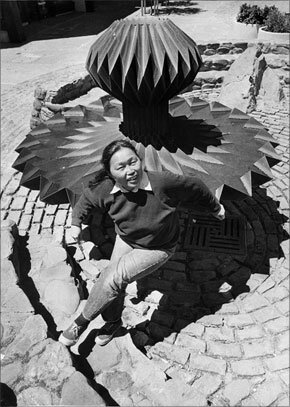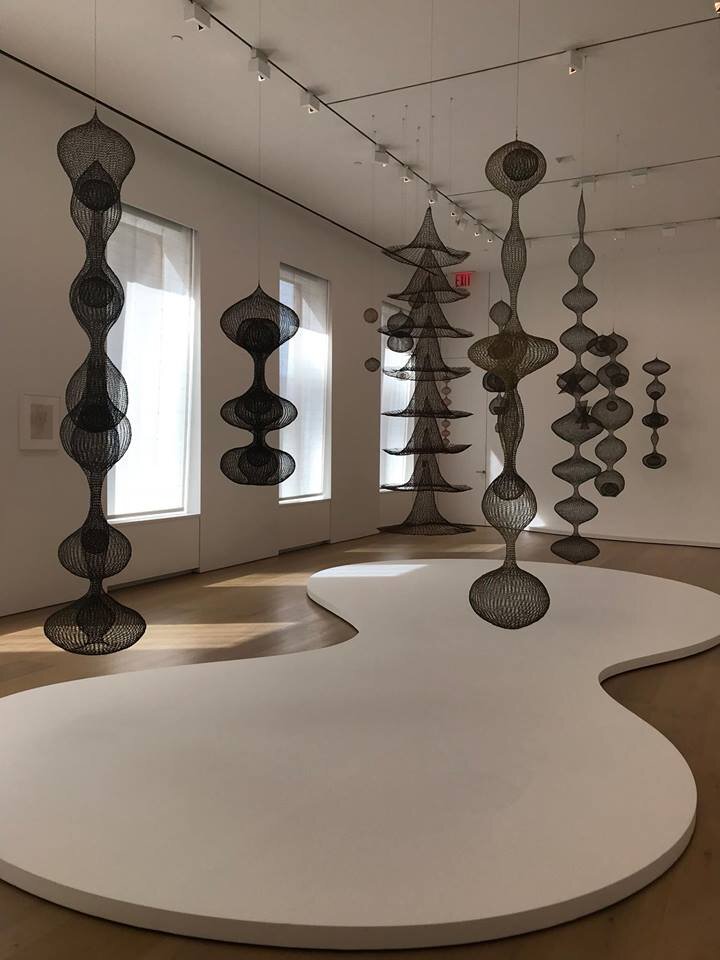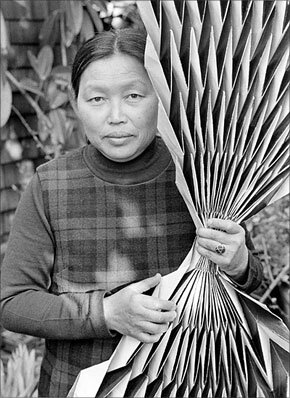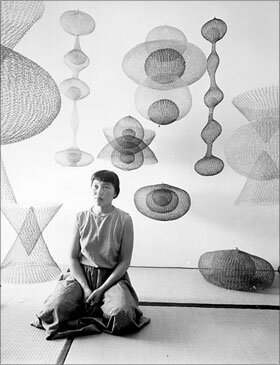Spotlight On: Ruth Asawa
(Image 1)
“My curiosity was aroused by the idea of giving structural form to the images in my drawings. These forms come from observing plants, the spiral shell of a snail, seeing light through insect wings, watching spiders repair their webs in the early morning, and seeing the sun through the droplets of water suspended from the tips of pine needles while watering my garden.”
Born in rural California, American sculptor, educator, and arts activist Ruth Asawa (1926–2013) was first exposed to professional artists while her family and other Japanese Americans were detained at Santa Anita, California, in 1942. Following her release from an internment camp in Rohwer, Arkansas, eighteen months later, she enrolled in 1943 in Milwaukee State Teachers College. Unable to receive her degree due to continued hostility against Japanese Americans, Asawa left Milwaukee in 1946 to study at Black Mountain College in North Carolina, then known for its progressive pedagogical methods and avant-garde aesthetic environment. Asawa’s time at Black Mountain proved formative in her development as an artist, and she was particularly influenced by her teachers Josef Albers, Buckminster Fuller, and the mathematician Max Dehn. She also met architectural student Albert Lanier, whom she would marry in 1949 and with whom she would raise a large family and build a career in San Francisco. Asawa continued to produce art steadily over the course of more than a half century, creating a cohesive body of sculptures and works on paper that, in their innovative use of material and form, deftly synthesizes a wide range of aesthetic preoccupations at the heart of twentieth-century abstraction.
Asawa’s work has been exhibited widely since the early 1950s, including early solo exhibitions in New York. Asawa continued to hold solo exhibitions in America throughout her life. In 2018-2019, the Pulitzer Arts Foundation in St. Louis presented Ruth Asawa: Life’s Work, the first major museum exhibition of the artist’s work in more than a decade. In 2022, Ruth Asawa: Citizen of the Universe will open at Modern Art Oxford, England, and will subsequently travel to the Stavanger Kunstmuseum, Norway. Throughout Asawa’s life the artist’s works were also included in significant group exhibitions internationally and continue to be exhibited since her passing. The artist’s work is represented in prominent museum collections across America.
Throughout her career Asawa used a few different methods to create her sculptures. In the 1950s she made looped wire sculptures, “A woven mesh not unlike medieval mail. A continuous piece of wire, forms envelop inner forms, yet all forms are visible (transparent). The shadow will reveal an exact image of the object.”
(Image 4)
In the 1960s the artist created tied wire sculptures, Asawa often describes these tied-wired sculptures using terms such as “tree” and “branching form.” She began with a centre stem of 200 to 1,000 wires, which she then divided into branches using nature as her model.
“I started in 1962 when a friend of ours brought a desert plant from Death Valley and said, ‘Here’s something for you to draw.’ I tried to draw it, but it was such a tangle that I had to construct it in wire in order to draw it. And then I got the idea that I could use it as a way to work in wire. I began to see all the possibilities: opening up the centre and then making it flat on the wall, and putting it on a stand.”
During her career she experimented with different cleaning methods and patinas and with the help of one plating company they came up with reverse electroplating techniques to achieve texture and different patinas on her sculptures.
The artist also experimented with cast forms in the mid 1960s She enjoyed working with the foundrymen at the San Francisco Art Foundry, and she was captivated by how she could take an idea from one material, add to it with wax, have it invested or made into a mould, and then see it transformed into bronze. She did this with wire, paper, baker’s clay, even persimmon stems. Her cast sculptures reaffirmed what she learned from her teacher Josef Albers at Black Mountain College, “The artist must discover the uniqueness and integrity of the material.”
Asawa is also well known for her public commissions, including a work outside the Grand Hyatt San Francisco (1973), the which includes hundreds of baker’s clay images moulded by local schoolchildren, friends, and other artists cast in bronze.
Upon moving to San Francisco in 1949, Asawa, a firm believer in the radical potential of arts education from her time at Black Mountain College, devoted herself to expanding access to art-focused educational programs. She co-founded the Alvarado Arts Workshop in 1968 and was instrumental in the opening of the first public arts high school in San Francisco in 1982, which was renamed the Ruth Asawa San Francisco School of the Arts in her honour in 2010.
(Image 5)
In 2020 the United States Postal Service honoured Asawa with a series of ten stamp designs featuring the artist’s signature wire sculptures, as well as a photograph of Asawa taken by Nat Farbman for Life magazine in 1954.
There is a lot more to read and see of Ruth Asawa’s sculpture and practice, here are some interesting links:
Click here to explore David Zwirner Gallery’s Asawa Catalogue. DZ Gallery exclusively represents Asawa’s estate.
Visit Ruth Asawa’s official website here.
Read this ArtNews article.
Look through the official Ruth Asawa Instagram page.
Listen to the latest episode of Bet You Wish This Was An Art Podcast which discusses the awful wave of American Asian hate crime currently happening in the US and Ruth Asawa’s own story of racism and resilience.
Watch this Youtube video, this one and this one.
Also, if you find any other inetresting links, please feel free to share them in the comments below!
Above biography information and excepts taken from David Zwirner Gallery and Ruth Asawa’s official website.
Image Captions: Image 1: Ruth Asawa, Untitled (detail), 1953-1965. Copper, Iron and brass wire (1926-2013) BAM, image courtesy of Flickr. Image 2: Ruth Asawa, image courtesy of Flickr. Image 3: Various Untitled works by Ruth Asawa at the David Zwirner gallery in NYC, image courtesy of WikiMedia Commons. Image 4: Ruth Asawa, Iron wire, de Young Museum, image courtesy of Flickr. Image 5: Ruth Asawa postage stamps, 2020, image courtesy of USPS. Image 6 and Image 7: Ruth Asawa, images courtesy of Flickr.






